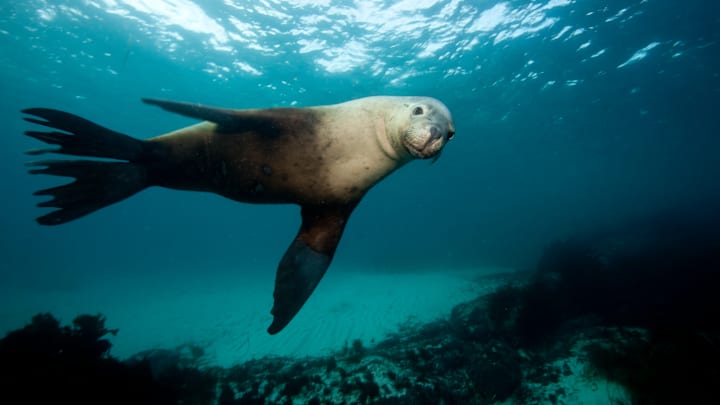Scientists have recruited the most adorable research partners—sea lions—to help them study ocean floors. With the aid of these friendly mammals, researchers from the University of Adelaide and the South Australian Research and Development Institute aim to better understand the seabeds of the Southern Australian coast.
For the study, published in Frontiers in Marine Science, scientists attached tiny, lightweight cameras and tracking instruments to eight Australian sea lions from the Olive Island and Seal Bay colonies. The equipment clocked in at less than 1 percent of each animal’s weight and allowed them to move freely. The researchers also chose female sea lions, knowing they would have to come back to land within a few days to nurse their pups; by the time the sea creatures returned they had recorded 89 hours of usable video between 16 and 360 feet deep. You can watch a clip from the footage showing a sea lion with her offspring below.
After the scientists analyzed the recordings, they identified six types of seabed habitats: sponge/sand, bare sand, macroalgae reef, macroalgae meadow, invertebrate reefs, and invertebrate boulders. This new information, combined with years of oceanographic data, enabled the researchers to build machine-learning models predicting which habitats can be found across Southern Australia‘s continental shelf.
Why sea lions? you may ask. Researching seabed habitats is no easy task for humans. Scientists are forced to use tricky-to-operate remotely operated underwater vehicles, or ROVs, to capture footage. This method requires ample time, money, and personnel, and can only be accomplished under certain weather conditions. Sea lions, meanwhile, are well-adapted to exploring the seafloor. They cover more ground more quickly than ROVs and are less affected by bad weather. Plus, outfitting the predators with tiny cameras is more cost-effective than building and operating a full vehicle from scratch.
Aside from mapping unexplored areas, animal-borne video data makes surveying habitats for endangered species easier. Marine populations have decreased by more than 60 percent in the past four decades. Scientists can use this research method to gain more comprehensive information about a threatened animal’s habitat while assessing other organisms.
Read More about Sea Animals:
